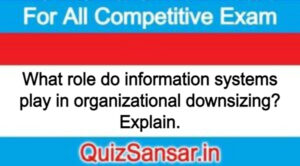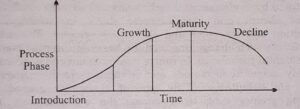
What role do information systems play in organizational downsizing? Explain.
What role do information systems play in organizational downsizing? Explain.
Ans.
This study explores the role information technology (IT) plays in organizational downsizing by studying two medium-sized American cities over a period of 10 years (1985-1995). Data were collected through 73 interviews, a questionnaire, and numerous documents. Four main findings emerged from the case studies. First, IT was found to facilitate organizational downsizing, but not to cause it. New City invested heavily in state-of-the-art IT over the years and more successfully downsized the organization than Old City, which lagged behind in IT investment and made no serious attempts to use IT as a tool to support strategic actions. Second, adverse environmental conditions triggered downsizing in both cities and determined the change strategies that managers used. When environmental pressures were mild (1985-1990), managers favoured a convergent change strategy that resulted in limited downsizing efforts and small personnel reductions. In contrast, when environmental pressures were strong (1990-1995), managers of both cities engaged in strategic reorientation and in downsizing efforts that led to larger personnel reductions. Third, the role IT played in organizational downsizing varied according to the change strategy. IT was used to facilitate work redesign in a convergent change strategy and to facilitate more significant structural and work redesign in strategic reorientation. Fourth, more integrated and better use of IT allowed managers of New City to downsize more rationally and efficiently. It facilitated the transfer of personnel within departments, from middle management to the operations level, and across departments, from internally oriented to customer-oriented personnel. In doing so, managers of New City minimized operating costs while maintaining the same level of services. In contrast, IT in Old City did not facilitate such an agenda and managers downsized more superficially across the board, in all departments. Differences in IT consequences in the two cities are explained using the theory of slack resources in organizations.
In view of the nature of the task, the organization is supposed to carry out, it has to be designed as an open system capable of adjusting itself to the changing environment. The organization continuously exchanges the information with the environment and is influenced by the changes in it. The organization, therefore, has to be built in such a fashion that it adjusts with the changes in the environment and that the goals and objectives are achieved.

Hence, the organization is a socio-technical system whose sub-systems are tasks, people technology, culture and structure, each having its own input and output satisfying at first own objectives and eventually the corporate organization’s goals and objectives. If the system’s goals and objectives are not congruent with the goals and objectives of the corporation, organization, poor performance, resistance to change and non-attainment of corporate go will be the consequences.
The systems and their goals are not stable. The goals change in response to the change in the business focus, the environment and in the people in the organization. A significance change calls for change in the organization structure. A goal displacement is said to have occur when the system goals replace the organization system goals. When a goal displacement occur it affects the organization’s goals significantly. Another reason for goals change is due to natural process of growth, and decline. This phenomenon is best described by a sigmoid S curve (Fig.).
All organizations and their business go through the different phases of growth cycle in state as, Introduction, Growth, Maturity and Decline. Each phase generates new goals to be served. If the changed or displaced goals are not reflected in the organization as a system, organization is bound to suffer from decay.
Organizational downsizing means the planned elimination of positions or jobs designed to improve organizational efficiency and effectiveness. The characteristics of downsizing are:
(1) It is undertaken purposively or intentionally, usually in response to environmental conditions such as economic slowdowns or hyper- competition.
(2) It involves reductions in personnel that might occur through direct elimination of jobs or indirectly, as a result of eliminating functions, hierarchical levels or entire units.
(3) It is aimed at improving the efficiency and/or effectiveness of the organization.
The nature of downsizing is contingent upon the change strategy used by the organization. Strategic re-orientation is revolutionary and characterized by short, discontinuous and radical changes. It is often precipitated by environmental turbulence and adverse conditions and involves abrupt and simultaneous shifts in strategy, power distribution and structure and operations systems. Top managers often initiate such change and mediate between internal inertia and environmental turbulence. In contrast, convergent change occurs over relatively longer time periods and is characterized by incremental change and adaptation. This type of change is geared toward achieving greater consistency among the organization’s internal activities.
Downsizing can result from either kind of change. When convergent change is undertaken, downsizing is expected to be incremental, require less re-design, be characterized by the desire to do the same things better and reinforce existing structures. Downsizing associated with strategic re-orientation is likely to be more severe and reflect an effort to do different things or to do the same things differently.
There are three broad downsizing approaches:
(1) Changes in work such as eliminating tasks, increasing span of control or standardizing work,
(2) Changes in technology such as eliminating jobs by automating work, or
(3) Changes in structure such as closing plants, eliminating hierarchical levels and merging, reorganizing or eliminating organizational units.
IT might play a different and more central role in organizational downsizing. Rather than being one of three relatively independent downsizing approaches, IT is likely to be a key enabler or facilitator of work and structural changes, which lead to organizational downsizing.
IT can help transforming organizational structures in two main ways, all of which facilitate downsizing.
(1) Catalyst in Redesign: IT can be a catalyst in the redesign of business processes. IT can help in performing major structural changes by automating inter-functional processes (e.g., budgeting, human resource management, planning), eliminating intermediaries, integrating different roles and tasks, automating organizational routines and routinizing complex decisions.
(2) Alter the Communications : IT can alter the communications across units and hierarchical levels in such a way as to facilitate the co-ordination and control of diverse activities.






